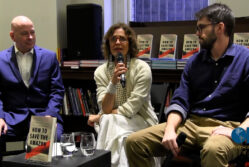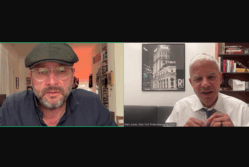Event Coverage Highlight

Iranian Filmmaker Gelareh Kiazand Discusses Creative Process With VICE Team
by Chad Bouchard
Freelancers and documentary filmmakers wishing to pitch stories to VICE News should use Gelareh Kiazand’s recent series on women in Iran as a “model” for the kind of storytelling producers want to see, panelists said during an OPC discussion on May 4.
In the latest “How I Did It” session, the second iteration of an OPC panel series focused on behind-the-scenes discussion among journalists and their editors, Kiazand talked with VICE News producer Milena Mikael Debass and supervising producer Courtney Brooks, who shared insight about her four-part documentary series about women in Iran breaking into professions and cultural spaces traditionally reserved for men.
New York Times United Nations bureau chief and OPC Governor Farnaz Fassihi moderated.
Kiazand said the first episode of the series “The Women Bikers of Iran,” focuses on a young actress in Tehran who took a police officer to court for pulling her over and telling her to get off her motorbike. Laws in Iran do not officially forbid women from riding motorbikes, though there are cultural barriers against it. She won her case against the officer. The episode also follows an elder woman in a rural are in the north who needed a motorbike to get around for work, and a community of women who helped her customize it.
“This inspired other women, especially her daughter, to ride motorbikes,” she said. “So it kind of showed other generations that it’s possible, but it also made it more acceptable among the men.”
Brooks said when Kiazand pitched this story to VICE, she saw that it would have many of the key elements she looks for in a piece.
“For other freelancers who might want to pitch to VICE, I think this was really a beautiful model of the best of VICE storytelling. [The episodes] were so beautifully shot and so visual, and so engaging and intimate.”
Other episodes in the series covered women working as auto mechanics and traditional fishing, and breaking into a traditional Iranian sport for the first time in 2000 years.
Brooks outlined specific elements that make up a good pitch, such as clear visual details, plenty of opportunity for B-roll, protagonists with a clear narrative arc, details about scale and scope of the story as well as wider implications, and what other media have covered the story, if any.
“Particularly for stories in high risk areas, I’m definitely looking for people at the very beginning with their idea, looking for indicators that the person I’m working with is also very aware of the risk and is going to be mitigating risk everywhere possible, even if it’s a riskier story.”
Mikael Debass said her work began mostly in the post-production phase, as a so-called “catching producer,” after footage had already been filmed. She said Kiazand and her team in Iran would take a first pass at editing, and then they would discuss preliminary scripts and the story arcs, and then send a condensed package of raw but selected material to be shaped.
“That’s where we get into crafting language to make the piece more accessible to an audience outside of Iran. The stories we were looking at had very specific nuance and context that, to someone who’s never lived in Iran they would not really grasp.”
She said in depicting the roadblocks that the women faced in each story, the team paid particular attention to fleshing out what unwritten rules were versus what was actually codified, and translating that into the voice-over scripts.
Brooks said that in preparation for the OPC session, she watched the Kiazand series again, and recalled how pleased she was with the result.
“The series felt very universal. And that’s something else we’re looking for in our international journalism. There’s a bit of a balance because we want it to be affecting for a U.S. audience and an international audience, as well as an Iranian audience. And I could tell that the series was going to do that. And I think it came through even more clearly than I’d hoped for.”
Click the window below to see a playlist of video clips or watch the entire program via the OPC’s YouTube channel.



